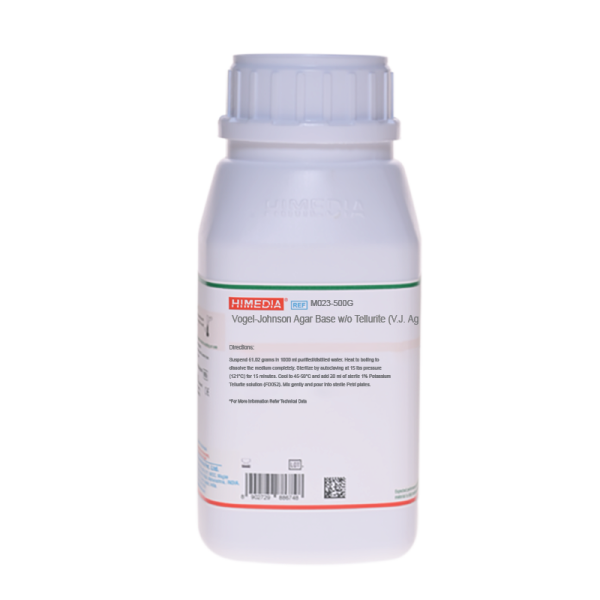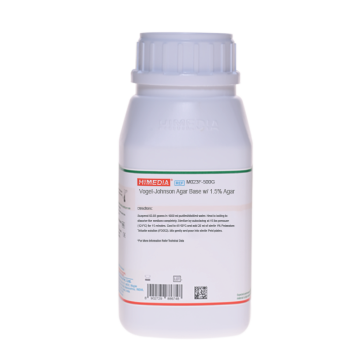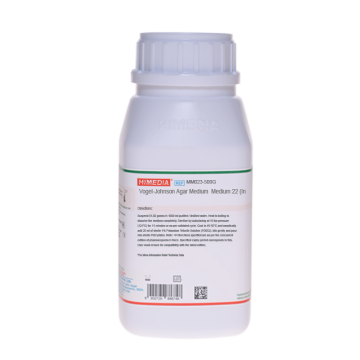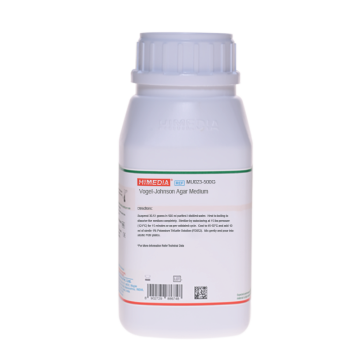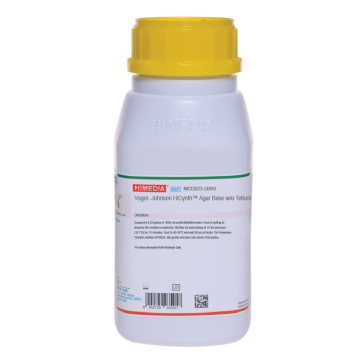 Your enquiry has been submitted
Your enquiry has been submitted
Vogel-Johnson Agar Base w/o Tellurite (V.J. Agar)
Staphylococcus aureus#CC293D
Intended Use
Recommended for selective isolation of coagulase positive, mannitol fermenting Staphylococcus aureus from heavily contaminated food and clinical specimens.
Composition
| Ingredients | g/L |
|---|---|
| Tryptone | 10.000 |
| Yeast extract | 5.000 |
| Mannitol | 10.000 |
| Dipotassium hydrogen phosphate | 5.000 |
| Lithium chloride | 5.000 |
| Glycine | 10.000 |
| Phenol red | 0.025 |
| Agar | 16.000 |
Final pH (at 25°C): 7.2±0.2
Formula adjusted, standardized to suit performance parameters
Directions
Suspend 61.02 grams in 1000 ml purified / distilled water. Heat to boiling to dissolve the medium completely. Sterilize by autoclaving at 15 lbs pressure (121°C) for 15 minutes. Cool to 45-50°C and add 20 ml of sterile PTe 1% Selective Supplement (FD052). Mix gently and pour into sterile Petri plates.
Principle And Interpretation
Staphylococcus aureus, a gram-positive, spherical bacterium, is a common colonizer of the human skin and mucosa. It causes skin and wound infections, urinary tract infections, pneumonia and bacteremia. It is also commonly implicated in food poisoning. It is also found as a common contaminant in pharmaceutical and cosmetics products (1). Vogel-Johnson Agar is prepared according to the formula devised by Vogel and Johnson (2) and is recommended for the microbial limit test in USP (3). Originally it was developed by Zebovitz (4), as a Tellurite Glycine Agar, a selective medium for the detection of coagulase-positive staphylococci. Vogel-Johnson modified the medium in 1960 by the addition of phenol red as a pH indicator and by increasing the quantity of mannitol (2). Selection and differentiation of coagulase-positive staphylococci on V.J. Agar is based on mannitol fermentation and tellurite reduction (5). V.J. Agar is specified in the standard methods for examination of cosmetics (1,6), pharmaceutical articles and nutritional supplements (3). In addition, the formulation complies with recommendations by the USP for microbial limit testing (3).
Tryptone and yeast extract provide nitrogenous and carbonaceous compounds, vitamin B complex and other growth nutrients. Dipotassium hydrogen phosphate provides buffering to the medium. During the first 24 hours, contaminating organisms are almost inhibited by tellurite, lithium chloride and high glycine content. The effect of inhibitors on S.aureus is reduced because of the presence of mannitol and glycine. Coagulase-positive staphylococci reduce potassium tellurite to metallic free tellurium and thus produce black colonies surrounded by yellow zones. This yellow colour is due to phenol red indicator that turns yellow in acidic condition due mannitol fermentation. If mannitol is not fermented, yellow zones are not formed. Also the colour of the medium around the colonies may even be a deeper red than normal due to utilization of the peptones in the medium. Prolonged incubation may result in growth of black coagulase-negative colonies.
Type of specimen
Clinical samples - pus samples, urine, wound samples, etc.; Food and dairy samples.
Specimen Collection and Handling
For clinical samples follow appropriate techniques for handling specimens as per established guidelines (7,8).
For food and dairy samples, follow appropriate techniques for sample collection and processing as per guidelines (9).
After use, contaminated materials must be sterilized by autoclaving before discarding.
Warning and Precautions
In Vitro diagnostic Use. For professional use only. Read the label before opening the container. Wear protective gloves/ protective clothing/eye protection/ face protection. Follow good microbiological lab practices while handling specimens and culture. Standard precautions as per established guidelines should be followed while handling clinical specimens. Safety guidelines may be referred in individual safety data sheets.
Limitations
- Individual organisms differ in their growth requirement and may show variable growth patterns on the medium.
- Each lot of the medium has been tested for the organisms specified on the COA. It is recommended to users to validate the medium for any specific microorganism other than mentioned in the COA based on the user's unique requirement.
- Further biochemical testing is required on colonies of pure culture for complete identification.
Performance and Evaluation
Performance of the medium is expected when used as per the direction on the label within the expiry period when stored at recommended temperature.
Quality Control
Appearance: Light yellow to pink homogeneous free flowing powder
Gelling: Firm, comparable with 1.6% Agar gel.
Colour and Clarity of prepared medium: Red coloured clear to slightly opalescent gel forms in Petri plates.
Reaction: Reaction of 6.1% w/v aqueous solution at 25°C. pH: 7.2±0.2
pH: 7.00-7.40
Cultural Response
Cultural characteristics observed with added sterile PTe 1% Selective Supplement (FD052), after an incubation at 35-37°C for 24-48 hours.
| Organism | Inoculum (CFU) | Growth | Recovery | Colour of colony | Mannitol fermentation |
|---|---|---|---|---|---|
| Escherichia coli ATCC 25922 (00013*) | >=104 | inhibited | 0% | - | - |
| Proteus mirabilis ATCC 25933 | 50-100 | poor | 10-20% | black | negative |
| Staphylococcus aureus subsp.aureus ATCC 25923 (00034*) | 50-100 | luxuriant | >=50% | black with yellow halo | positive |
| Staphylococcus epidermidis ATCC 12228 (00036*) | 50-100 | Fair-good | 30-40% | translucent to blackish | negative |
| Escherichia coli ATCC 8739 (00012*) | >=104 | inhibited | 0% | - | - |
| Staphylococcus aureus subsp. aureus ATCC 6538 (00032*) | 50-100 | luxuriant | >=50% | black with yellow halo | positive |
Key: (*) Corresponding WDCM numbers.
Storage and Shelf Life
Store between 10-30°C in a tightly closed container and the prepared medium at 20-30°C. Use before expiry date on the label. On opening, product should be properly stored dry, after tightly capping the bottle in order to prevent lump formation due to the hygroscopic nature of the product. Improper storage of the product may lead to lump formation. Store in dry ventilated area protected from extremes of temperature and sources of ignition Seal the container tightly after use. Product performance is best if used within stated expiry period.
Disposal
User must ensure safe disposal by autoclaving and/or incineration of used or unusable preparations of this product. Follow established laboratory procedures in disposing of infectious materials and material that comes into contact with clinical sample must be decontaminated and disposed of in accordance with current laboratory techniques (7,8).
Reference
- FDA Bacteriological Analytical Manual, 2016, AOAC, Washington, D.C.
- Vogel R. A. and Johnson M. J., 1960, Public Health Lab. 18:131.
- United States Pharmacopeia, 2019. United States Pharmacopeial Convention, Inc., Rockville, Md.
- Zebovitz E., Evans J. B. and Niven C. F., 1955, J. Bacteriol., 70:686.
- MacFaddin J. F., 1985, Media for Isolation-Cultivation-Identification-Maintenance of Medical Bacteria, Vol. 1, Williams & Wilkins, Baltimore, Md.
- Curry A. S., Graf J. G. and McEwen G. M., (Eds.), 1993, CTFA Microbiology Guidelines, The Cosmetic, Toiletry and Fragrance Association, Washington, D.C.
- Isenberg, H.D. Clinical Microbiology Procedures Handbook. 2nd Edition.
- Jorgensen, J.H., Pfaller, M.A., Carroll, K.C., Funke, G., Landry, M.L., Richter, S.S and Warnock., D.W. (2015)Manual of Clinical Microbiology, 11th Edition. Vol. 1.
- Salfinger Y., and Tortorello M.L., 2015, Compendium of Methods for the Microbiological Examination of Foods, 5th Ed., American Public Health Association, Washington, D.C.
| Product Name | Vogel-Johnson Agar Base w/o Tellurite (V.J. Agar) |
|---|---|
| SKU | M023 |
| Product Type | Regular |
| Physical Form | Powder |
| Origin | Animal |
| Packaging type | HDPE |
| References | 1. Vogel R. A. and Johnson M. J., 1960, Public Health Lab. 18:131. 2.United States Pharmacopeia, 200 3.Zebovitz E., Evans J. B. and Niven C. F., 1955, J. Bacteriol., 70:686. 4.FDA Bacteriological Analytical Manual, 2005, 18th Ed., AOAC, Washington, D.C. 5.MacFaddin J. F., 1985, Media for Isolation-Cultivation-Identification-Maintenance of Medical Bacteria, Vol. 1, Williams& Wilkins, Baltimore, Md. 6.Curry A. S., Graf J. G. and McEwen G. M., (Eds.), 1993, CTFA Microbiology Guidelines, The Cosmetic, Toiletry andFragrance Association, Washington, D.C. |
| Customized Product Available | No |



